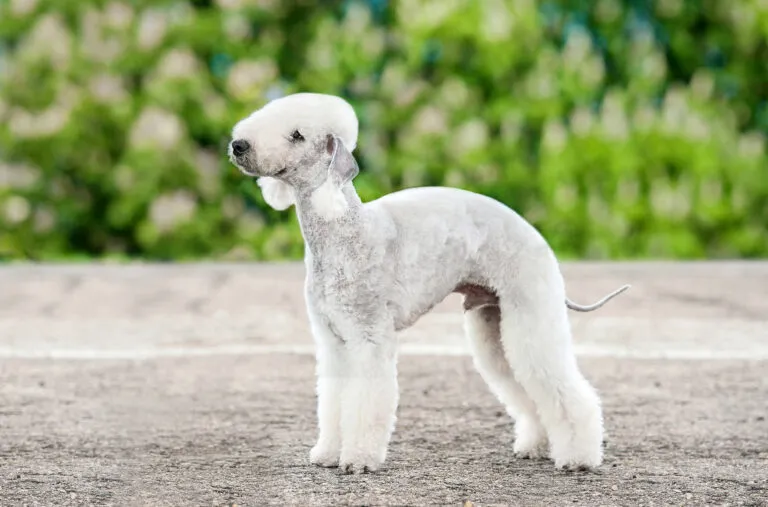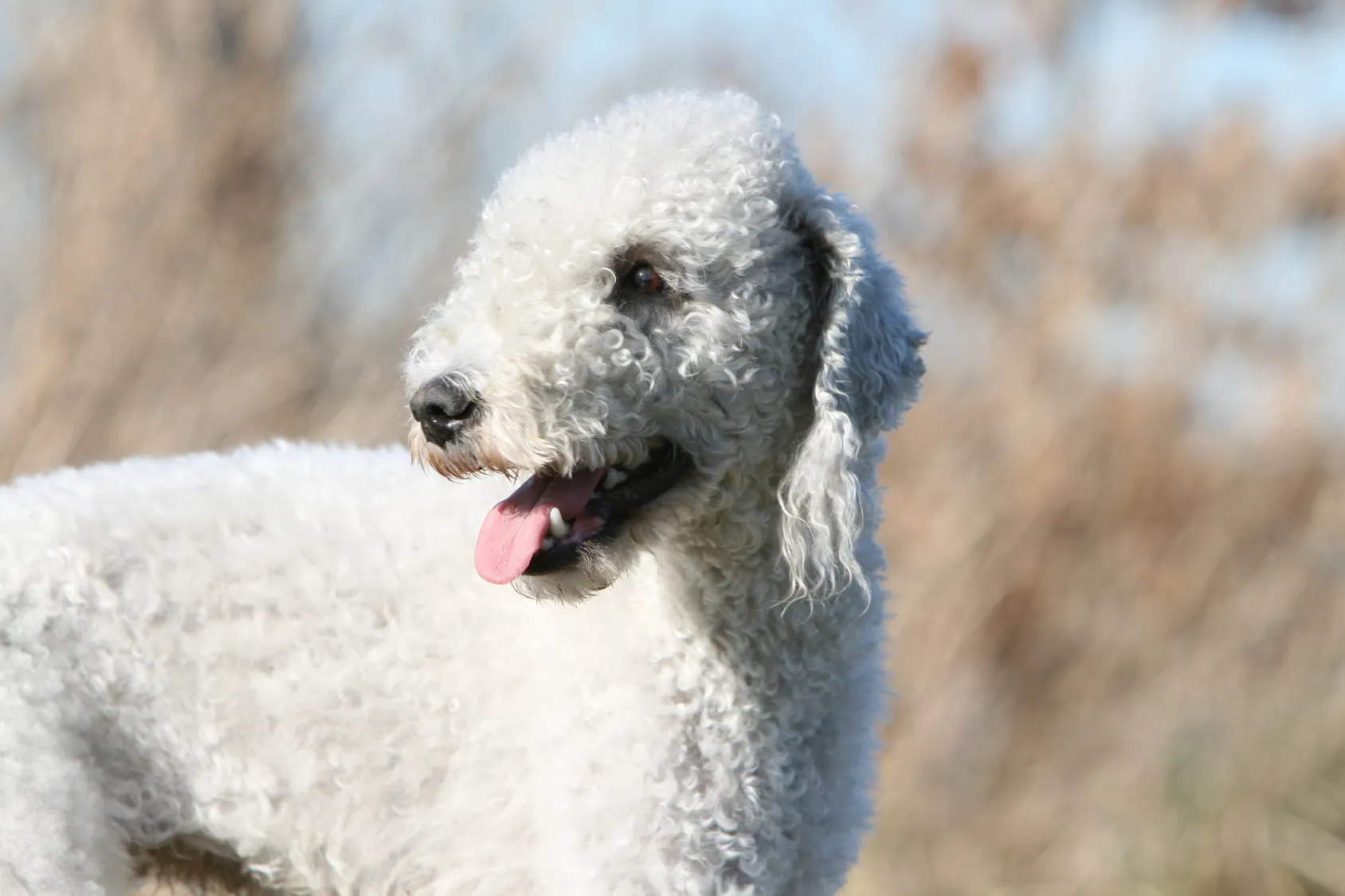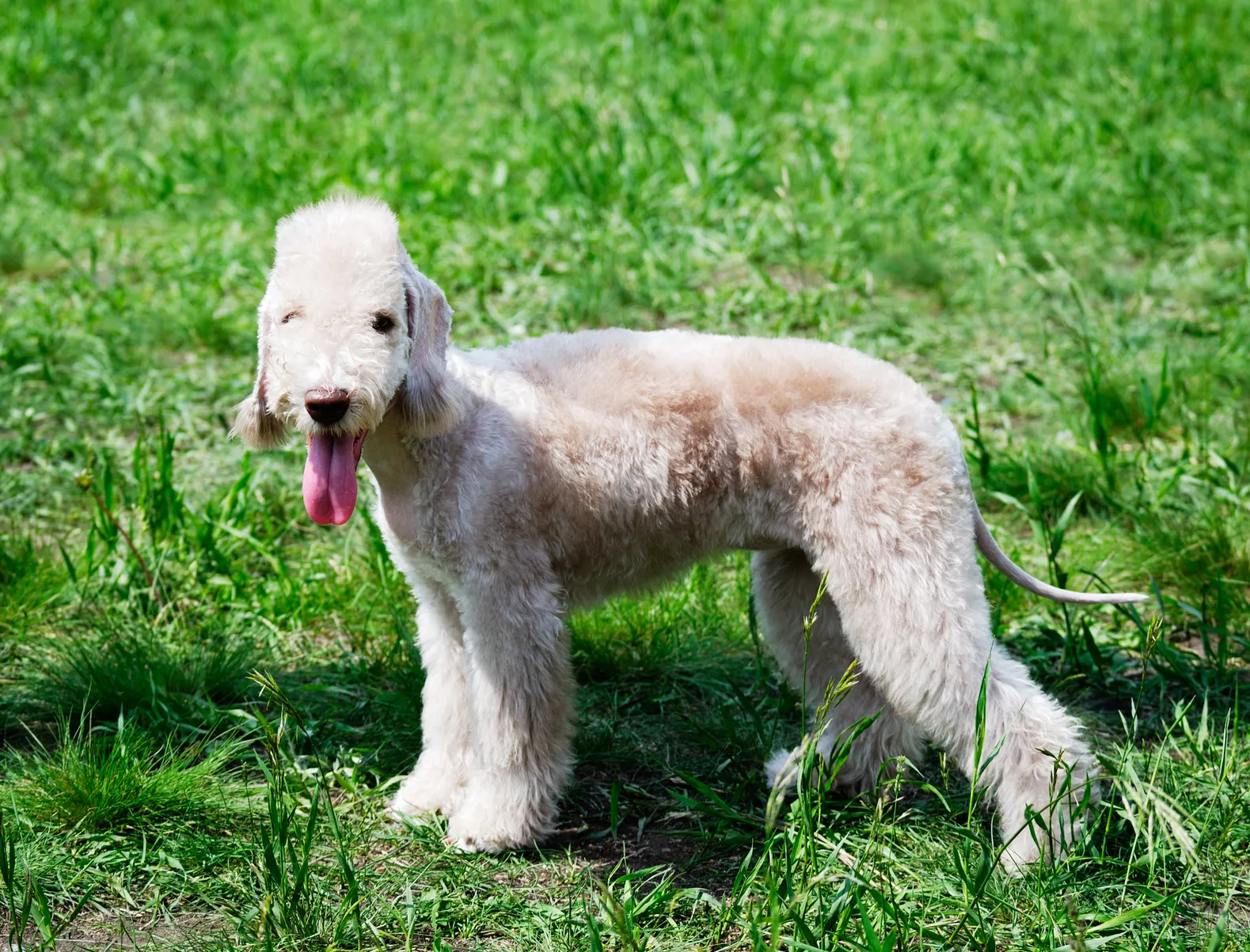Medium Size Poodle
The Bedlington Terrier physically resembles a sheep, but behind this tousled look lies an intelligent hunter, wily behind its floppy ears in woods and open fields. Owners of these dogs love their tender and patient nature. The Bedlington Terrier is a dog for people who like a robust character.

© Grigorita Ko / stock.adobe.com
The medium-sized Bedlington Terrier should appear both graceful and muscular, with trademark thick and slightly wavy fur protruding from the skin. The fur is either blue-grey with dark eyes and a black nose or liver- or sand-coloured, in which cases the eyes are pale and the nose is brown. The body is athletic and wiry, and the low-set tail should not be carried over the back. An adult Bedlington Terrier reaches an approximate height of 40cm and weighs 8 to 10kg.
Previously, these curly-haired dogs were predominantly the companions of the poor, since they were classed as reliable rat and hare catchers by poor poachers in the mining region of the North of England, where they were also deployed in the mines. In addition, they frequently accompanied tinkers, scissor grinders or traders as “four-legged pest controllers”: whilst the humans handled trade, the dogs freed the places of rats and could earn their masters a few extra pennies.
Unfortunately, these terriers were also deployed for wagers on fights. This and the associated incompatibility with other dogs probably also led to the name “wolf in sheep’s clothing”. They were also known as Rothbury Terriers for some time. Scottish Terriers, Whippets and Otterhounds make up its ancestors. In 1820, scheduled breeding commenced of the Bedlington Terrier, named after a town north of Newcastle, where the first exhibition with the new breed took place in 1870.
In 1877, the first breeding association was founded, after which these curly-haired terriers spread throughout Europe: in Germany, fans of this breed joined together in the “Fachschaft für Bedlington Terrier” in 1932. However, the Bedlington Terrier never become a fashion dog and remains relatively rare, but some fans do complain that the breed can now barely still be taken seriously as a working dog, since the focus of breeding has turned more in the direction of companion dogs. There is also talk of crossing with Poodles in some lines, which should supposedly make grooming easier. If you’re interested in a Bedlington Terrier as a family companion dog, you should research which breeder is most suitable or what an older dog is like in terms of background.
 © Dogs / stock.adobe.com
© Dogs / stock.adobe.com
These terriers in sheep’s clothing are actually as meek as little lambs in their own home: they are very affectionate and fixated by their caregiver, but not in an intrusive or demanding way. They are calm, pleasant and tender – also with children, with whom they love to play. Outside though, the “wolf” with an immense hunting instinct comes to the fore: males in particular do not like unknown dogs – especially not in their own territory. If they are agitated, it can be difficult to calm these dogs down again. Human strangers are mostly tolerated. Bedlington Terriers are temperamental, ready to defend themselves and thereby very vigilant, although they do not tend to yap. As soon as their owner initiates activities they can do together, these dogs get fully involved.
First-time dog owners can also successfully train Bedlington Terriers if they thoroughly explore training for terriers. However, puppies of this breed can at times be very challenging, because they are very relentless and also like to constantly test their limits. Patience and a consistent demeanour are needed if you want to assert yourself as leader of the pack on a permanent basis. You should definitely do so, because an untrained Bedlington Terrier can soon become unpleasant – especially concerning the hunting instinct and social compatibility. Bonus points for easily training a Bedlington Terrier are its great willingness to learn and close bond to its caregiver. Bear in mind that only a sufficiently stimulated dog can also be well-trained. In any case, it makes sense to look for a dog school in order to have a positive impact on this breed’s social compatibility.
The breed has a slight tendency to develop copper toxicosis, whereby an excessive amount of copper is stored in the liver. This can largely be excluded though by relevant health examinations involving blood or hair root DNA tests on animals to be deployed for breeding. Otherwise, some lines can be affected more than others by ocular diseases. In any case, it is advisable to turn to a serious breeder who offers healthcare provision when purchasing a puppy, since healthy ancestors are the best form of investment in your dog’s health. Apart from the aforementioned dispositions, the Bedlington Terrier is a very robust breed, which can live to be around 14 years in age if cared for well.
Feed the wolf and not the sheep in your Bedlington Terrier, meaning that the main component of the food should be high-quality meat. Meat should also be the first ingredient listed on the packaging. A high-quality food does not contain any grain either – regardless of whether you opt for wet or dry food. The calorie intake of these dogs depends primarily on how much exercise they do – hence, the manufacturer’s recommendations are only broad guidelines. Weigh adult Bedlington Terriers once a month and adapt the quantity of food accordingly if your dog has lost or gained weight. If you wish to switch food, you should make the transition slowly so that your Bedlington Terrier doesn’t vomit or suffer from diarrhoea as a a result of any intolerances or allergic reactions. It’s recommended to mix slightly more of the new food into the usual one on a day-by-day basis. Snacks can also be healthy: treat your dog to freeze-dried meat treats or dental care snacks. Dried chewing products like cattle ears satisfy your dog’s urge to chew. Always freely provide fresh water for your companion.
The good news is that these dogs don’t moult much and hardly give off any typical “dog odour”. However, grooming does require some work. Ideally, Bedlington Terriers should be combed or brushed once to twice per day. You should leave regularly cutting and trimming the fur to a professional dog groomer, who should take care of the typical sheep look at least once a year. Regularly check the lop ears and if necessary, clean them with a special ear cleanser for dogs. You also need to check your companion’s claws: when it comes to lighter and older dogs in particular, their claws are often not worn away sufficiently, so there could be a risk of injury due to the claws being too long. Cut the claws to a safe length with special clippers – your vet will be happy to help you if you are unsure. Some dog owners get their pet used to having their teeth brushed with a special dog toothbrush and toothpaste from the puppy phase: a good opportunity to prevent tartar into old age.
 © Vtls / stock.adobe.com
© Vtls / stock.adobe.com
There’s lots to experience with a Bedlington Terrier: these sporty, medium-sized dogs are ideally suited for dog sports like agility and can also make good companion dogs for jogging or horse-riding – if you can keep their immense hunting instinct under control. They are tireless on walks and up for all sorts of fun indoors too – for instance, these clever little dogs love to learn new tricks. Many Bedlington Terriers are water lovers and relish the opportunity to swim, since they are outstanding and fast swimmers. Make sure that your beloved pet doesn’t catch a cold after swimming in cool waters. Obedience, man-trailing or dog dancing – try things out together to see what is most fun for both you. Of course, your Bedlington Terrier also enjoys rest periods that are equally important – ideally together with you. Relaxation is part of a species-appropriate canine life.
These terriers in sheep’s clothing are right for you if you like and are able to handle the typically headstrong terrier charm. Although you don’t necessary need lots of experience with dogs, you should at least be willing to do research and attend a dog school with your terrier. If your Bedlington Terrier gets enough exercise, it can feel perfectly at ease living in an apartment. Like all dogs though, it will naturally be happy to be able to run around in its own – fenced – garden. The crucial factor is it being able to spend plenty of time with its human family and being mentally and physically stimulated and challenged. In this sense, it is not a dog for lazy individuals.
The Bedlington Terrier is suitable for families, as well as for singletons who like to have their dog close by. They tend to just be dogs for one person, as they are particularly attached to their main caregiver, but they mainly get on very well with other family members too. The Bedlington Terrier should have grown up with cats if it is to live with them. Due to its strong hunting instinct, it should definitely not be left unsupervised in a room with small animals. In principle, it’s not advisable to keep these former rat catchers with small animals like guinea pigs or even rats.
Before you make the final decision to offer a Bedlington Terrier a home, you should be aware of the responsibility you will be taking on in the coming years. This breed requires lots of time on a daily basis for grooming and activity. As well, you should calculate in advance what recurring costs you will face: these include the costs of a high-quality food, veterinary appointments and an experienced dog groomer, as well as dog tax and insurance. Consider too how you will care for your dog when you are sick or on holiday. Top tip: there is no problem for you to take a well-trained Bedlington Terrier with you on a hiking holiday. Nowadays more and more hotels welcome pets accompanying their guests. Definitely clarify before the move if there are any allergy sufferers in your home – especially if this is your first dog.
This breed is relatively rare in most countries other than Britain. For instance, only around two dozen puppies belonging to this breed have been born in Germany in the last few years. So if you’re looking for a young Bedlington Terrier, you may have to travel quite some distance and wait for some time in order to end up with the dog of your dreams. The wait is worthwhile though: responsible breeders place great importance on breeding examinations, which are compulsory to be a member of a Terrier Club. If there are very few dogs belonging to a specific breed, some expertise is required in order to continue breeding. Breeders with a sense of responsibility also make sure that offspring are true-to-type and well socialised. The latter isn’t just a product of appropriate selection, but also comprehensive socialisation in the first few weeks of the puppy’s life. Your puppy can move in with you at the of eight weeks at the earliest.
Are you looking for an adult dog? Finding an adult pedigree Bedlington Terrier is a matter of pure luck, since the breed is very rare. You will probably only strike lucky searching online, where you can contact terrier associations that can give you tips on looking for a Bedlington Terrier. Hybrids looking for a new home may even be a possibility for you.
We wish you lots of joy with your little terrier in sheep’s clothing!
Fans of the Bearded Collie agree that those who aren't familiar with this dog breed simply have to get acquainted with it. And those who have experienced how a Bearded Collie bolts across meadows with its flowing fur, how it rolls around full of energy and joy and how it attentively and observantly takes into account its owners wishes become simply addicted to this original dog breed and its unique charm.
The Goldendoodle isn't a breed, but a pairing between Golden Retrievers and Medium or Standard Poodles. Marketed as a low-maintenance dog for allergy sufferers, this hybrid is enjoying increasing popularity amongst dog lovers, similar to the Labradoodle.